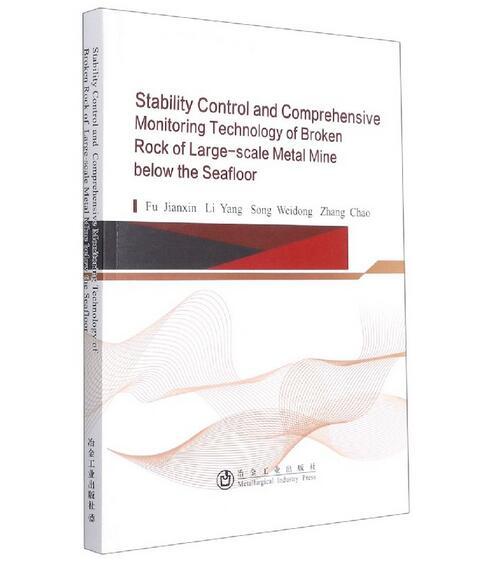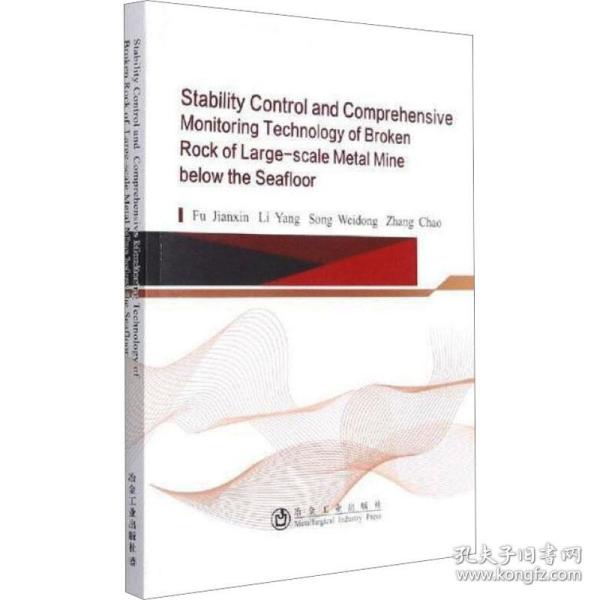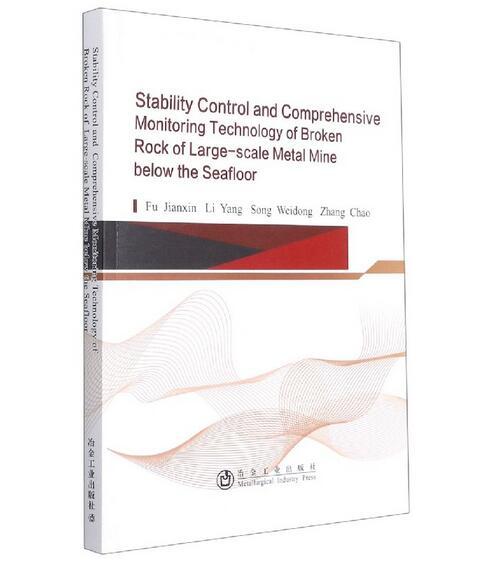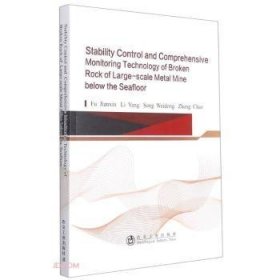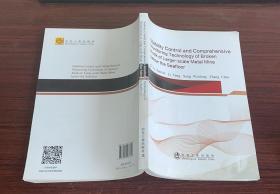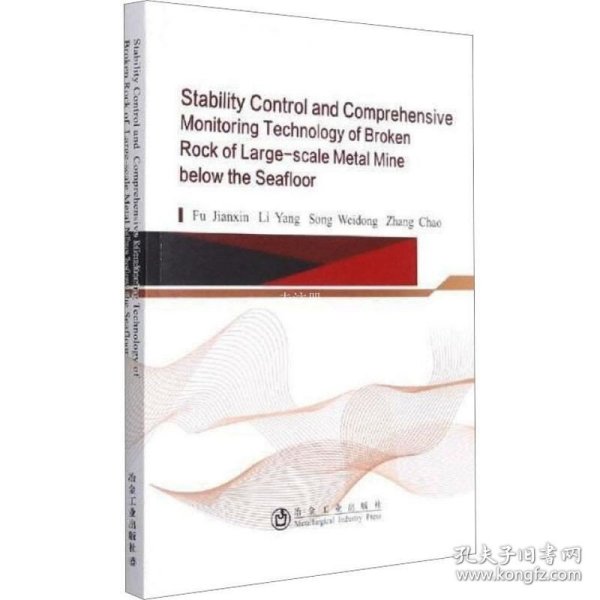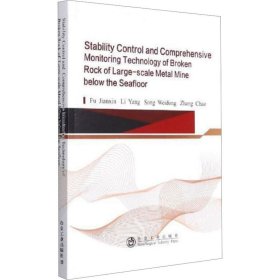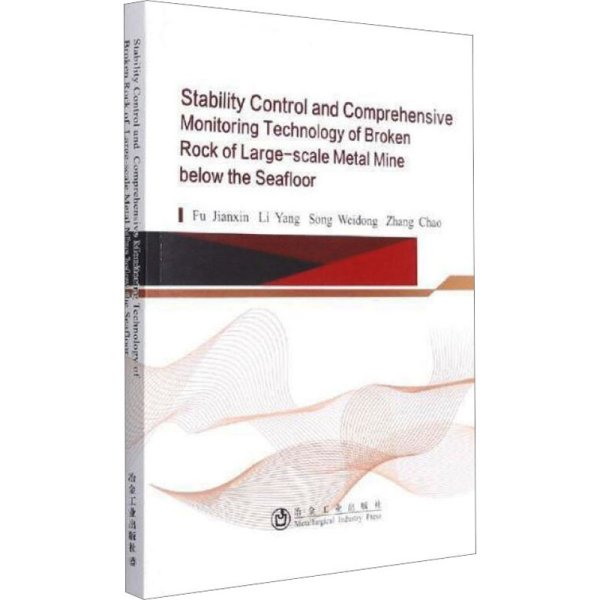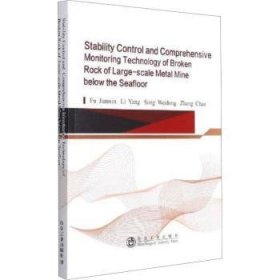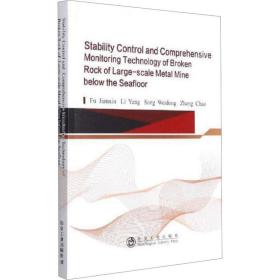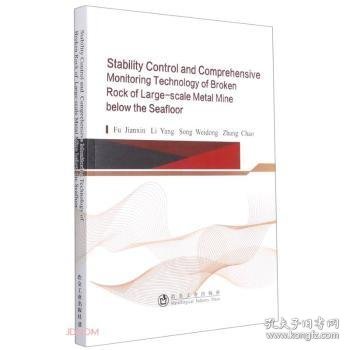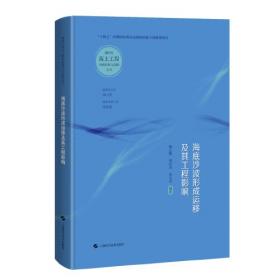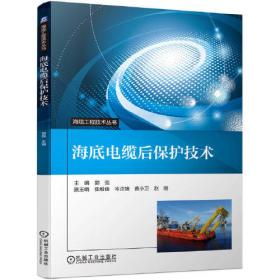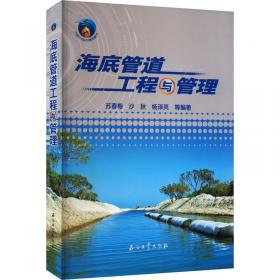海底基岩大型金属矿山破碎矿岩稳定性控制及多元综合监测技术(英文版)
出版时间:
2021-04
版次:
1
ISBN:
9787502487690
定价:
80.00
装帧:
平装
开本:
16开
页数:
285页
-
本书结合著作者在三山岛金矿长期的工程经验,系统的总结了大型海底金矿地质隐患的探测、处理技术及监测技术,可为海底金矿的安全高效开采提供技术支撑,主要内容包括海底资源开采概述、三山岛金矿西南翼矿段工程地质评价及三维模型、应力-渗流耦合作用下的破碎矿岩物理力学特性及本构模型、海底基岩开采隐伏采空区及塌陷区分布、海底破碎矿岩及采空区充填注浆加固技术、基于多源信息融合的破碎矿岩稳定性评价、海底破碎矿岩稳定性多元立体综合监测系统及海底破碎矿岩稳定性监测数据分析。 1 Summary
1.1 Overview of marine mineral resources
1.2 Development history of submarine bedrock deposit mining
2 Engineering geological evaluation and three-dimensional model of the southwest area of Sanshandao Gold Mine
2.1 The geographical location of Sanshandao Gold Mine
2.2 Introduction of ore block in southwest area
2.2.1 Geological situation
2.2.2 Mining conditions
2.2.3 The method of underwater mining
2.2.4 Mining status
2.2.5 Mineral reserves
2.3 Distribution characteristics of overlying strata in southwest wing ore block
2.3.1 Quaternary
2.3.2 Distribution characteristics of quaternary water layer
2.3.3 Distribution characteristics of bedrock weathering zone
2.4 Distribution characteristics of regional faults
2.4.1 Geological characteristics of Xinli main fault (F1)
2.4.2 Structural activity of fault zone in Xinli mining area
2.4.3 Characteristics of ore controlling fault zone (F3) in southwest wing of Xinli mining area
2.4.4 The NW trending fault (F2)
2.4.5 Small-scale fault
2.5 Three dimensional model of ore block in southwest area
2.5.1 Modeling data
2.5.2 Construction of seabed model
2.5.3 Establishment of orebody entity and goal model
2.5.4 Establishment of roadway model
2.5.5 Establishment of fault and fracture zone model
2.5.6 Overall model
2.5.7 Goaf modeling
3 Physical and mechanical properties and constitutive model of fractured rock under the coupling of stress and seepage
3.1 Processing and preparation of rock sample
3.2 Study on porosity of rock sample
3.2.1 Indoor water saturation test
3.2.2 Determination of longitudinal wave velocity
3.2.3 Construction of elastic P-wave and porosity model
3.3 Experimental study on stress seepage coupling of the rock sample
3.3.1 Test equipment and test specimen
3.3.2 Test scheme and test principle ana]ysis
3.3.3 Ana]ysis of stress-strain characteristics
3.3.4 Seepage characteristics ana]ysis
3.3.5 Deformation characteristic an&lysis
3.3.6 Failure characteristics analysis of rock sample
3.4 Construction of stress seepage coupling constitutive model
3.4.1 Effective stress principle
3.4.2 Strain equivalence principle
3.4.3 Construction of the constitutive model
3.4.4 Calculation of parameters in the model
4 The distribution of buried goaf and subsidence area in submarine bedrock mining
4.1 Field survey of goat and subsidence area
4.2 Drilling to survey goaf
4.3 Geological radar detection
4.3.1 Selecting detection instrument and parameter
4.3.2 Determine the dielectric constant of surrounding rock and filling body
4.3.3 Test point arrangement
4.3.4 Processing and analyzing detection data
4.3.5 Analysis of detection results
5 Filling grouting reinforcement technology for seabed broken rock and goaf
5.1 Determination of filling grouting position
5.2 Retaining engineering stability control measures
5.2.1 Retaining roadway support design
5.2.2 Design of shaft cover
5.2.3 Retaining wall design
5.3 Grouting reinforcement technology of Large Dosage Fly Ash-cement mixture
5.3.1 Test materials and equipment
5.3.2 Strength test of fly ash cement test block
5.3.3 Syneresis rate test
5.3.4 Stone rate test
5.3.5 On-site industrial test
5.3.6 Optimization of the proportioning scheme and expected economic benefits
6 Stability evaluation of broken ore and rock based on multi-source information fusion
6.1 Simulation analysis of rock mass stability in the southwest area
6.1.1 Building models
6.1.2 Selection of mechanical parameters of ore and rock
6.1.3 Boundary condition
6.1.4 Simulation scheme
6.1.5 Numerical simulation analysis
6.1.6 Seepage mechanism and stability analysis of aquiclude
6.2
-
内容简介:
本书结合著作者在三山岛金矿长期的工程经验,系统的总结了大型海底金矿地质隐患的探测、处理技术及监测技术,可为海底金矿的安全高效开采提供技术支撑,主要内容包括海底资源开采概述、三山岛金矿西南翼矿段工程地质评价及三维模型、应力-渗流耦合作用下的破碎矿岩物理力学特性及本构模型、海底基岩开采隐伏采空区及塌陷区分布、海底破碎矿岩及采空区充填注浆加固技术、基于多源信息融合的破碎矿岩稳定性评价、海底破碎矿岩稳定性多元立体综合监测系统及海底破碎矿岩稳定性监测数据分析。
-
目录:
1 Summary
1.1 Overview of marine mineral resources
1.2 Development history of submarine bedrock deposit mining
2 Engineering geological evaluation and three-dimensional model of the southwest area of Sanshandao Gold Mine
2.1 The geographical location of Sanshandao Gold Mine
2.2 Introduction of ore block in southwest area
2.2.1 Geological situation
2.2.2 Mining conditions
2.2.3 The method of underwater mining
2.2.4 Mining status
2.2.5 Mineral reserves
2.3 Distribution characteristics of overlying strata in southwest wing ore block
2.3.1 Quaternary
2.3.2 Distribution characteristics of quaternary water layer
2.3.3 Distribution characteristics of bedrock weathering zone
2.4 Distribution characteristics of regional faults
2.4.1 Geological characteristics of Xinli main fault (F1)
2.4.2 Structural activity of fault zone in Xinli mining area
2.4.3 Characteristics of ore controlling fault zone (F3) in southwest wing of Xinli mining area
2.4.4 The NW trending fault (F2)
2.4.5 Small-scale fault
2.5 Three dimensional model of ore block in southwest area
2.5.1 Modeling data
2.5.2 Construction of seabed model
2.5.3 Establishment of orebody entity and goal model
2.5.4 Establishment of roadway model
2.5.5 Establishment of fault and fracture zone model
2.5.6 Overall model
2.5.7 Goaf modeling
3 Physical and mechanical properties and constitutive model of fractured rock under the coupling of stress and seepage
3.1 Processing and preparation of rock sample
3.2 Study on porosity of rock sample
3.2.1 Indoor water saturation test
3.2.2 Determination of longitudinal wave velocity
3.2.3 Construction of elastic P-wave and porosity model
3.3 Experimental study on stress seepage coupling of the rock sample
3.3.1 Test equipment and test specimen
3.3.2 Test scheme and test principle ana]ysis
3.3.3 Ana]ysis of stress-strain characteristics
3.3.4 Seepage characteristics ana]ysis
3.3.5 Deformation characteristic an&lysis
3.3.6 Failure characteristics analysis of rock sample
3.4 Construction of stress seepage coupling constitutive model
3.4.1 Effective stress principle
3.4.2 Strain equivalence principle
3.4.3 Construction of the constitutive model
3.4.4 Calculation of parameters in the model
4 The distribution of buried goaf and subsidence area in submarine bedrock mining
4.1 Field survey of goat and subsidence area
4.2 Drilling to survey goaf
4.3 Geological radar detection
4.3.1 Selecting detection instrument and parameter
4.3.2 Determine the dielectric constant of surrounding rock and filling body
4.3.3 Test point arrangement
4.3.4 Processing and analyzing detection data
4.3.5 Analysis of detection results
5 Filling grouting reinforcement technology for seabed broken rock and goaf
5.1 Determination of filling grouting position
5.2 Retaining engineering stability control measures
5.2.1 Retaining roadway support design
5.2.2 Design of shaft cover
5.2.3 Retaining wall design
5.3 Grouting reinforcement technology of Large Dosage Fly Ash-cement mixture
5.3.1 Test materials and equipment
5.3.2 Strength test of fly ash cement test block
5.3.3 Syneresis rate test
5.3.4 Stone rate test
5.3.5 On-site industrial test
5.3.6 Optimization of the proportioning scheme and expected economic benefits
6 Stability evaluation of broken ore and rock based on multi-source information fusion
6.1 Simulation analysis of rock mass stability in the southwest area
6.1.1 Building models
6.1.2 Selection of mechanical parameters of ore and rock
6.1.3 Boundary condition
6.1.4 Simulation scheme
6.1.5 Numerical simulation analysis
6.1.6 Seepage mechanism and stability analysis of aquiclude
6.2
查看详情
-
全新
北京市丰台区
平均发货23小时
成功完成率88.57%
-
全新
江苏省无锡市
平均发货10小时
成功完成率92.91%
-
全新
四川省成都市
平均发货9小时
成功完成率97.01%
-
全新
山东省泰安市
平均发货24小时
成功完成率92.51%
-
全新
江苏省宿迁市
平均发货25小时
成功完成率87.66%
-
全新
四川省成都市
平均发货15小时
成功完成率91.64%
-
全新
江苏省苏州市
平均发货9小时
成功完成率95.75%
-
全新
山东省济宁市
平均发货69小时
成功完成率80.57%
-
全新
山东省泰安市
平均发货23小时
成功完成率85.42%
-
全新
山东省泰安市
平均发货8小时
成功完成率92.79%
-
全新
北京市通州区
平均发货9小时
成功完成率88.6%
-
全新
北京市丰台区
平均发货8小时
成功完成率90.33%
-
全新
上海市黄浦区
平均发货11小时
成功完成率94.51%
-
全新
山东省泰安市
平均发货18小时
成功完成率92.29%
-
全新
北京市朝阳区
平均发货19小时
成功完成率84.99%
-
全新
北京市通州区
平均发货10小时
成功完成率88.5%
-
全新
北京市通州区
平均发货11小时
成功完成率94.13%
-
八五品
北京市通州区
平均发货43小时
成功完成率87.39%
-
全新
北京市东城区
平均发货30小时
成功完成率83.91%
-
全新
江苏省南京市
平均发货7小时
成功完成率97.83%
-
全新
北京市海淀区
平均发货11小时
成功完成率93.18%
-
全新
山东省泰安市
平均发货9小时
成功完成率88.01%
-
全新
江苏省无锡市
平均发货8小时
成功完成率95.83%
-
全新
江苏省南京市
平均发货16小时
成功完成率82.85%
-
全新
江苏省南京市
平均发货8小时
成功完成率96.65%
-
全新
河北省保定市
平均发货15小时
成功完成率91.13%
-
全新
广东省广州市
平均发货21小时
成功完成率80.21%
-
全新
广东省广州市
平均发货7小时
成功完成率89.93%
-
全新
广东省广州市
平均发货18小时
成功完成率87.79%
-
全新
浙江省嘉兴市
平均发货12小时
成功完成率92.81%
-
全新
广东省广州市
平均发货9小时
成功完成率87.76%
-
全新
湖北省武汉市
平均发货20小时
成功完成率87.42%

 占位居中
占位居中

